Accounting Fundamentals
VerifiedAdded on 2023/01/10
|17
|3038
|46
AI Summary
This document provides a comprehensive understanding of accounting fundamentals, including journal entries, trial balance, financial statements, and the importance of final reports to different users. It also discusses the concepts of liquidity and profitability and compares and contrasts them. Suitable for students studying accounting or anyone interested in gaining a deeper understanding of accounting principles.
Contribute Materials
Your contribution can guide someone’s learning journey. Share your
documents today.

Accounting Fundamentals
Secure Best Marks with AI Grader
Need help grading? Try our AI Grader for instant feedback on your assignments.
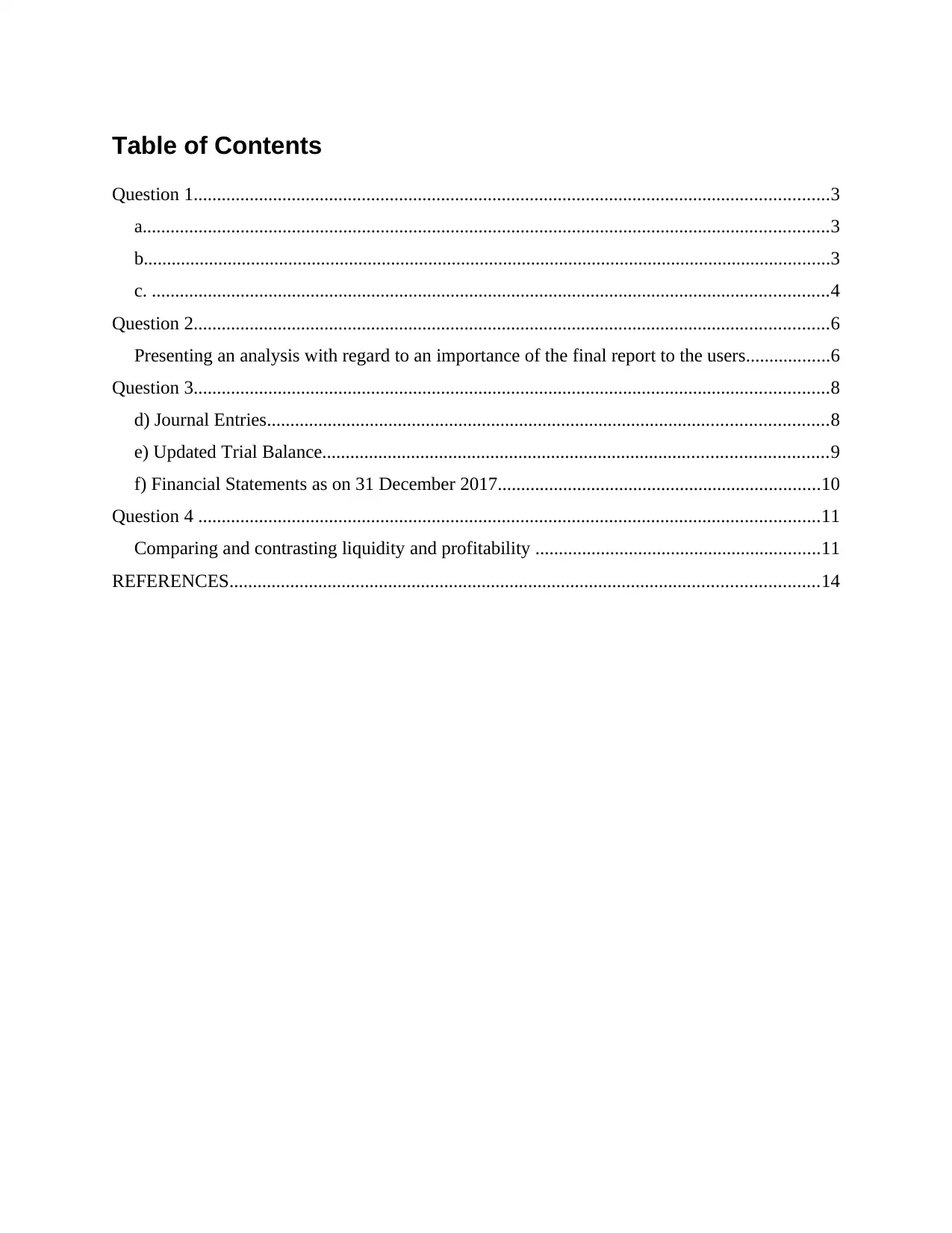
Table of Contents
Question 1........................................................................................................................................3
a...................................................................................................................................................3
b...................................................................................................................................................3
c. .................................................................................................................................................4
Question 2........................................................................................................................................6
Presenting an analysis with regard to an importance of the final report to the users..................6
Question 3........................................................................................................................................8
d) Journal Entries........................................................................................................................8
e) Updated Trial Balance............................................................................................................9
f) Financial Statements as on 31 December 2017.....................................................................10
Question 4 .....................................................................................................................................11
Comparing and contrasting liquidity and profitability .............................................................11
REFERENCES..............................................................................................................................14
Question 1........................................................................................................................................3
a...................................................................................................................................................3
b...................................................................................................................................................3
c. .................................................................................................................................................4
Question 2........................................................................................................................................6
Presenting an analysis with regard to an importance of the final report to the users..................6
Question 3........................................................................................................................................8
d) Journal Entries........................................................................................................................8
e) Updated Trial Balance............................................................................................................9
f) Financial Statements as on 31 December 2017.....................................................................10
Question 4 .....................................................................................................................................11
Comparing and contrasting liquidity and profitability .............................................................11
REFERENCES..............................................................................................................................14
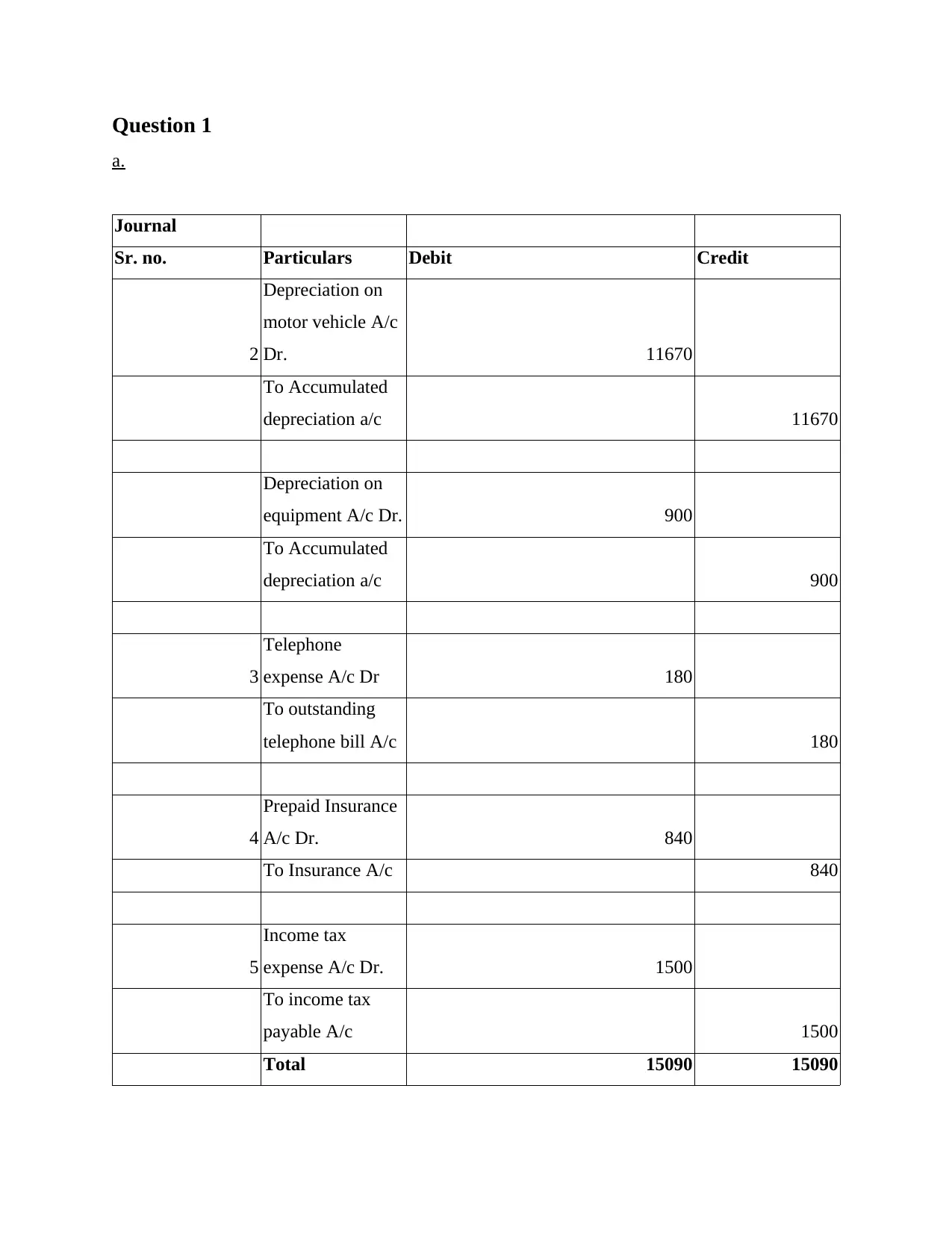
Question 1
a.
Journal
Sr. no. Particulars Debit Credit
2
Depreciation on
motor vehicle A/c
Dr. 11670
To Accumulated
depreciation a/c 11670
Depreciation on
equipment A/c Dr. 900
To Accumulated
depreciation a/c 900
3
Telephone
expense A/c Dr 180
To outstanding
telephone bill A/c 180
4
Prepaid Insurance
A/c Dr. 840
To Insurance A/c 840
5
Income tax
expense A/c Dr. 1500
To income tax
payable A/c 1500
Total 15090 15090
a.
Journal
Sr. no. Particulars Debit Credit
2
Depreciation on
motor vehicle A/c
Dr. 11670
To Accumulated
depreciation a/c 11670
Depreciation on
equipment A/c Dr. 900
To Accumulated
depreciation a/c 900
3
Telephone
expense A/c Dr 180
To outstanding
telephone bill A/c 180
4
Prepaid Insurance
A/c Dr. 840
To Insurance A/c 840
5
Income tax
expense A/c Dr. 1500
To income tax
payable A/c 1500
Total 15090 15090
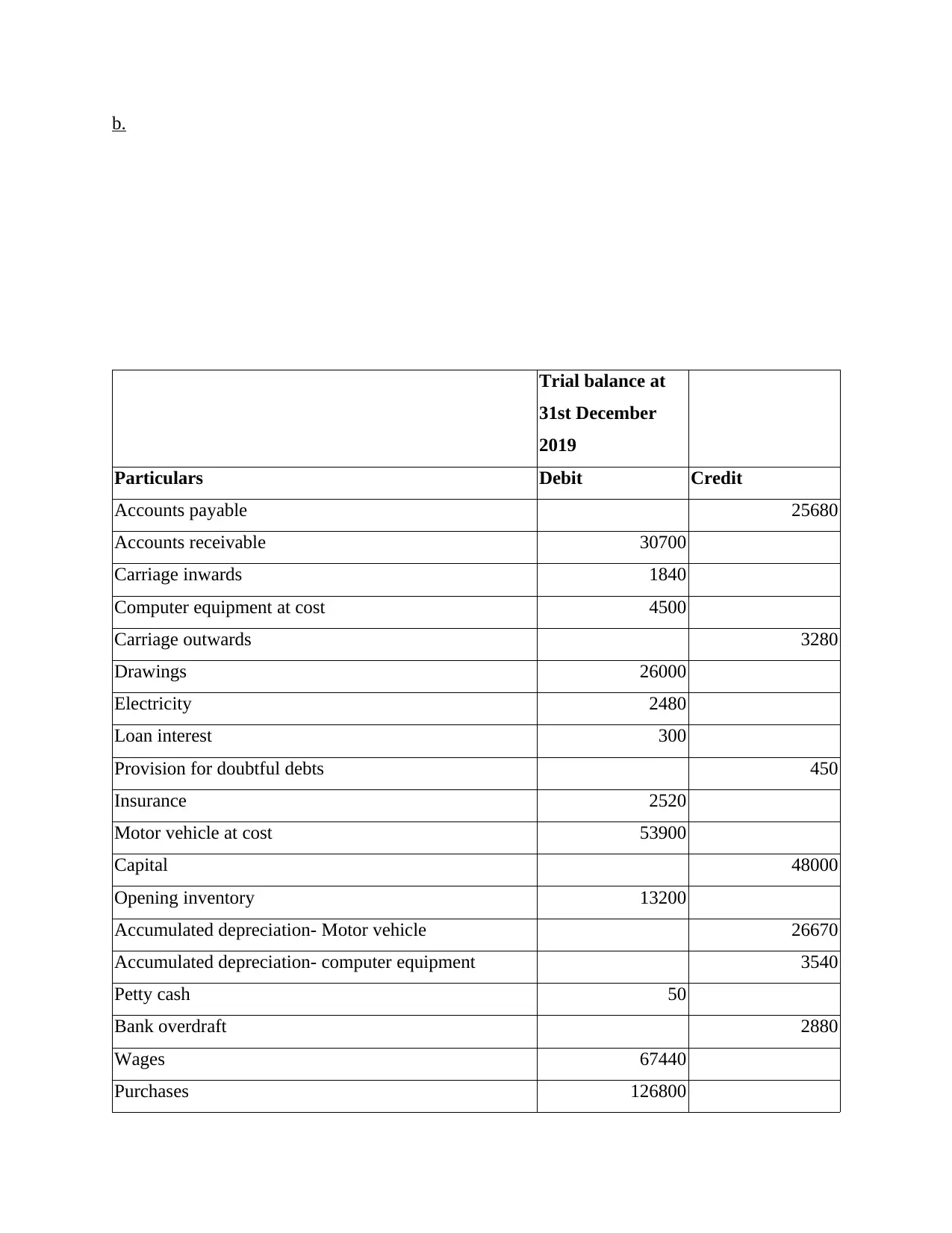
b.
Trial balance at
31st December
2019
Particulars Debit Credit
Accounts payable 25680
Accounts receivable 30700
Carriage inwards 1840
Computer equipment at cost 4500
Carriage outwards 3280
Drawings 26000
Electricity 2480
Loan interest 300
Provision for doubtful debts 450
Insurance 2520
Motor vehicle at cost 53900
Capital 48000
Opening inventory 13200
Accumulated depreciation- Motor vehicle 26670
Accumulated depreciation- computer equipment 3540
Petty cash 50
Bank overdraft 2880
Wages 67440
Purchases 126800
Trial balance at
31st December
2019
Particulars Debit Credit
Accounts payable 25680
Accounts receivable 30700
Carriage inwards 1840
Computer equipment at cost 4500
Carriage outwards 3280
Drawings 26000
Electricity 2480
Loan interest 300
Provision for doubtful debts 450
Insurance 2520
Motor vehicle at cost 53900
Capital 48000
Opening inventory 13200
Accumulated depreciation- Motor vehicle 26670
Accumulated depreciation- computer equipment 3540
Petty cash 50
Bank overdraft 2880
Wages 67440
Purchases 126800
Secure Best Marks with AI Grader
Need help grading? Try our AI Grader for instant feedback on your assignments.
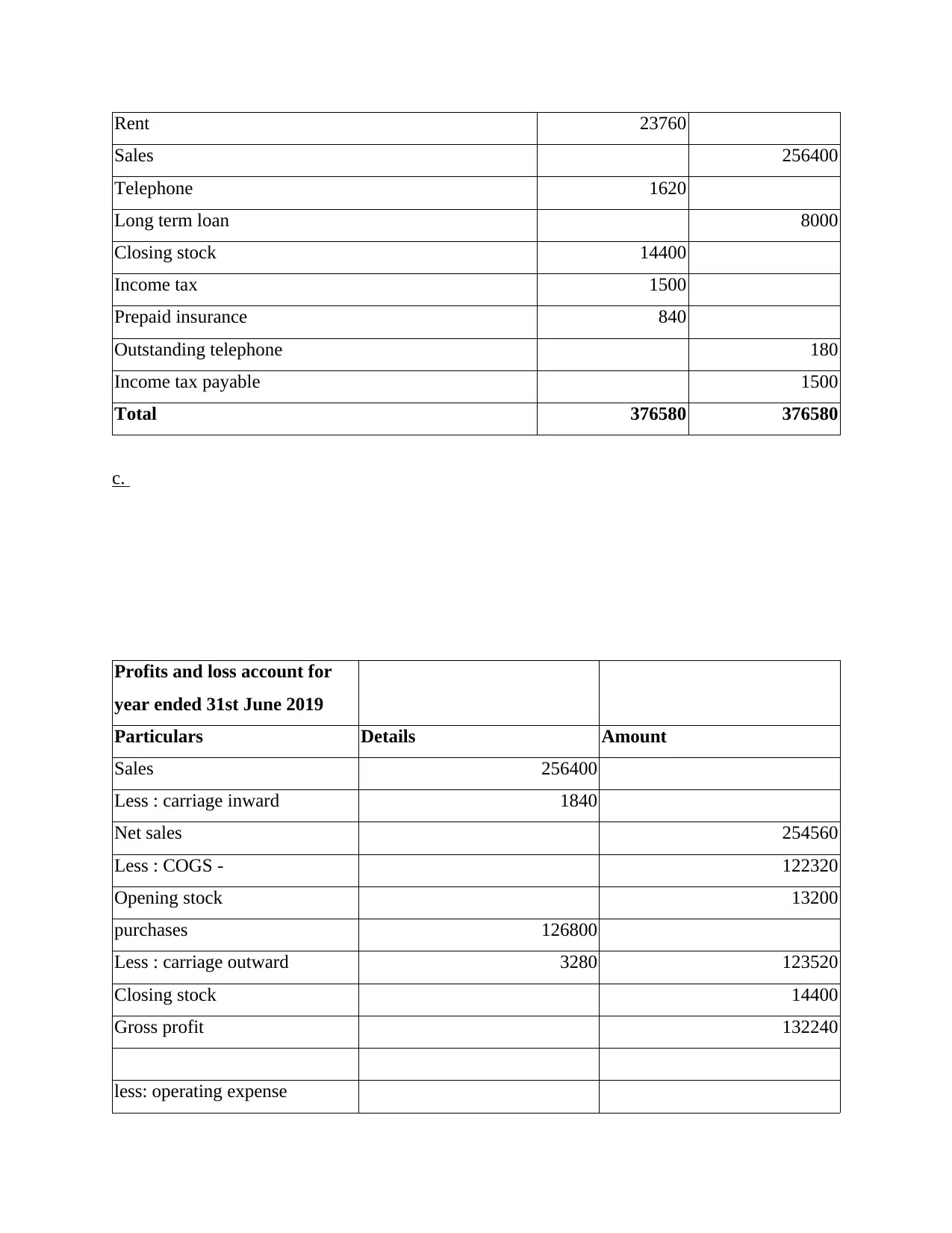
Rent 23760
Sales 256400
Telephone 1620
Long term loan 8000
Closing stock 14400
Income tax 1500
Prepaid insurance 840
Outstanding telephone 180
Income tax payable 1500
Total 376580 376580
c.
Profits and loss account for
year ended 31st June 2019
Particulars Details Amount
Sales 256400
Less : carriage inward 1840
Net sales 254560
Less : COGS - 122320
Opening stock 13200
purchases 126800
Less : carriage outward 3280 123520
Closing stock 14400
Gross profit 132240
less: operating expense
Sales 256400
Telephone 1620
Long term loan 8000
Closing stock 14400
Income tax 1500
Prepaid insurance 840
Outstanding telephone 180
Income tax payable 1500
Total 376580 376580
c.
Profits and loss account for
year ended 31st June 2019
Particulars Details Amount
Sales 256400
Less : carriage inward 1840
Net sales 254560
Less : COGS - 122320
Opening stock 13200
purchases 126800
Less : carriage outward 3280 123520
Closing stock 14400
Gross profit 132240
less: operating expense
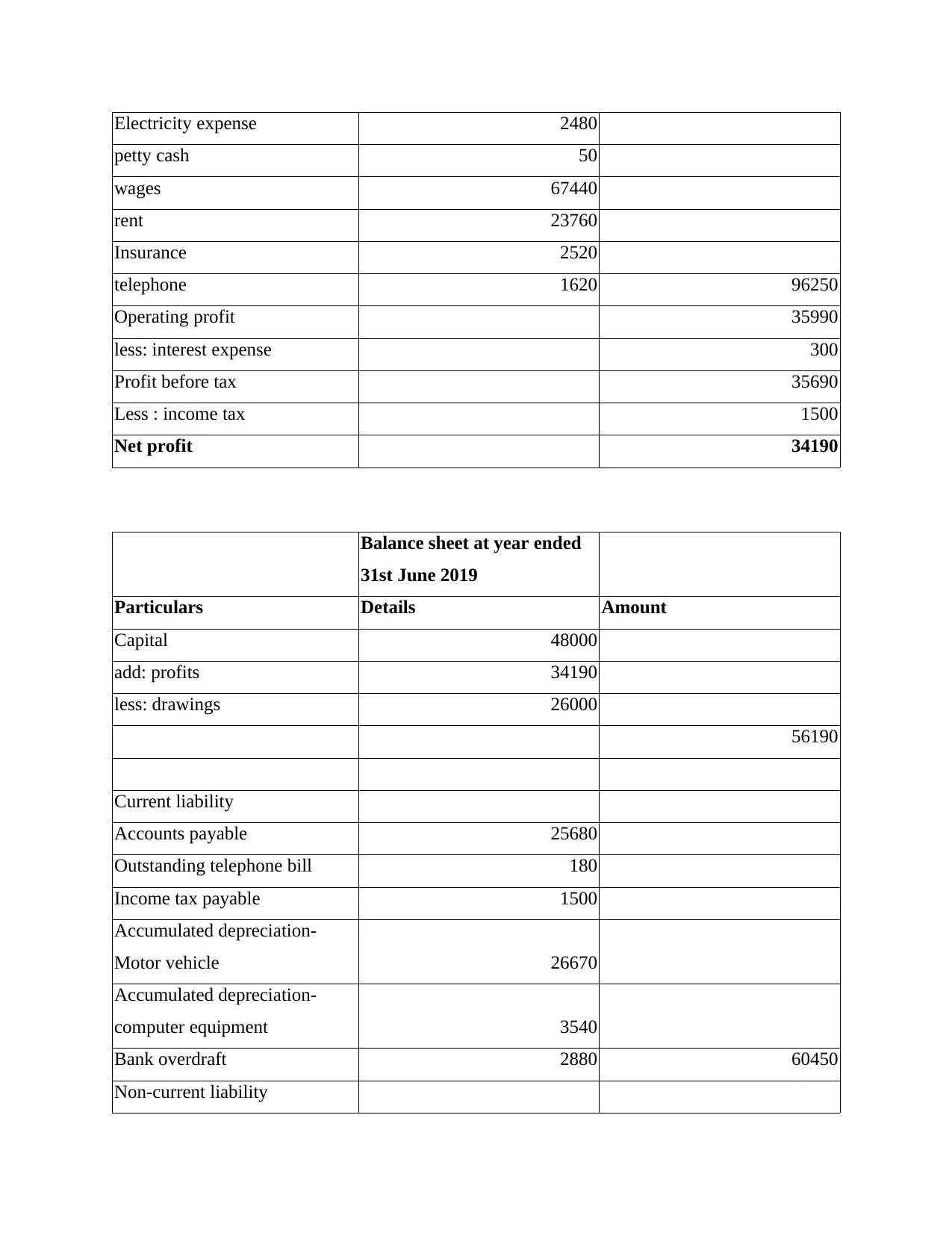
Electricity expense 2480
petty cash 50
wages 67440
rent 23760
Insurance 2520
telephone 1620 96250
Operating profit 35990
less: interest expense 300
Profit before tax 35690
Less : income tax 1500
Net profit 34190
Balance sheet at year ended
31st June 2019
Particulars Details Amount
Capital 48000
add: profits 34190
less: drawings 26000
56190
Current liability
Accounts payable 25680
Outstanding telephone bill 180
Income tax payable 1500
Accumulated depreciation-
Motor vehicle 26670
Accumulated depreciation-
computer equipment 3540
Bank overdraft 2880 60450
Non-current liability
petty cash 50
wages 67440
rent 23760
Insurance 2520
telephone 1620 96250
Operating profit 35990
less: interest expense 300
Profit before tax 35690
Less : income tax 1500
Net profit 34190
Balance sheet at year ended
31st June 2019
Particulars Details Amount
Capital 48000
add: profits 34190
less: drawings 26000
56190
Current liability
Accounts payable 25680
Outstanding telephone bill 180
Income tax payable 1500
Accumulated depreciation-
Motor vehicle 26670
Accumulated depreciation-
computer equipment 3540
Bank overdraft 2880 60450
Non-current liability
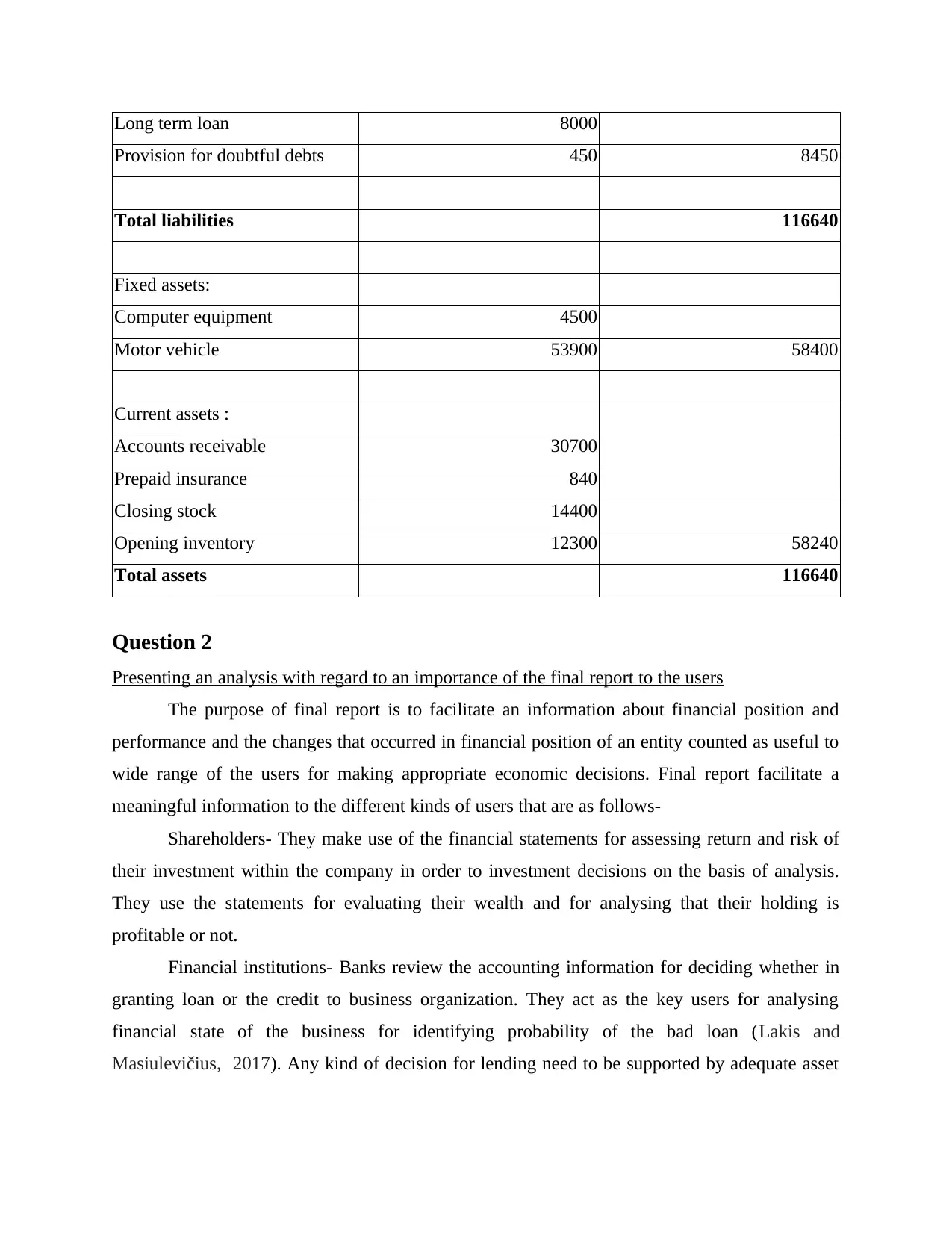
Long term loan 8000
Provision for doubtful debts 450 8450
Total liabilities 116640
Fixed assets:
Computer equipment 4500
Motor vehicle 53900 58400
Current assets :
Accounts receivable 30700
Prepaid insurance 840
Closing stock 14400
Opening inventory 12300 58240
Total assets 116640
Question 2
Presenting an analysis with regard to an importance of the final report to the users
The purpose of final report is to facilitate an information about financial position and
performance and the changes that occurred in financial position of an entity counted as useful to
wide range of the users for making appropriate economic decisions. Final report facilitate a
meaningful information to the different kinds of users that are as follows-
Shareholders- They make use of the financial statements for assessing return and risk of
their investment within the company in order to investment decisions on the basis of analysis.
They use the statements for evaluating their wealth and for analysing that their holding is
profitable or not.
Financial institutions- Banks review the accounting information for deciding whether in
granting loan or the credit to business organization. They act as the key users for analysing
financial state of the business for identifying probability of the bad loan (Lakis and
Masiulevičius, 2017). Any kind of decision for lending need to be supported by adequate asset
Provision for doubtful debts 450 8450
Total liabilities 116640
Fixed assets:
Computer equipment 4500
Motor vehicle 53900 58400
Current assets :
Accounts receivable 30700
Prepaid insurance 840
Closing stock 14400
Opening inventory 12300 58240
Total assets 116640
Question 2
Presenting an analysis with regard to an importance of the final report to the users
The purpose of final report is to facilitate an information about financial position and
performance and the changes that occurred in financial position of an entity counted as useful to
wide range of the users for making appropriate economic decisions. Final report facilitate a
meaningful information to the different kinds of users that are as follows-
Shareholders- They make use of the financial statements for assessing return and risk of
their investment within the company in order to investment decisions on the basis of analysis.
They use the statements for evaluating their wealth and for analysing that their holding is
profitable or not.
Financial institutions- Banks review the accounting information for deciding whether in
granting loan or the credit to business organization. They act as the key users for analysing
financial state of the business for identifying probability of the bad loan (Lakis and
Masiulevičius, 2017). Any kind of decision for lending need to be supported by adequate asset
Paraphrase This Document
Need a fresh take? Get an instant paraphrase of this document with our AI Paraphraser

base and the liquidity. This reporting helps the banking institution in anticipating an ability of
borrower in paying back the loaned funds and the related interest charges.
Managers- They need the financial information for managing routine affairs of the
corporation by analysing their financial performance & health so that they could be able to take
operational decisions in appropriate manner. They require such information for understanding
the liquidity, profitability and the cash flows of an entity for each and every month so that it
could make the financing & operational decisions regarding business.
Prospective investors- They are the main parties who need financial informations for
tracking the performance of their investment. They act as the owners of business and needs
accounting related data for deciding whether to invest or withdraw the investment made by them.
With the use of financial information an investor could assess the viability of the project and
might predict the future dividends on the basis of the profits disclosed or reported in the
statement. Furthermore, it also enables in determining the risk attached with an investment that
may gauged from final reports. For example- fluctuating profits reflects higher risk and
therefore, it provides as the basis for an investment decisions of the potential investors.
Suppliers- they need the information for analysing credit worthiness of the business and
in ascertaining whether to supply the goods on the credit terms or not. They require to know if
they would be repaid on time and that the credit terms are been set as per analysis of customer's
financial state. Thus, they would be requiring the statement for the purpose of deciding whether
it is safe for extending the credit to the firm or not.
Employees- They use the final report for computing the profitability of the company and
its conditions on the future remuneration and the security of job. An entity might elect for
facilitating its financial information to the employees with detailed explanation of the
information that a document contains. This could be used for increasing level of the employee
involvement and in understanding the business.
Customers- When the customer selects the supplier for major contracts, it needs to review
their final report initially for judging or measuring financial capability of the supplier for
remaining within the business for long enough in providing proper goods and services mandated
in a contract. This helps them to investigate whether the supplier is having adequate resources for
ensuring steady supply of the goods in the future. This specially vital or important where
consumers is more of dependent on the supplier for specialized element.
borrower in paying back the loaned funds and the related interest charges.
Managers- They need the financial information for managing routine affairs of the
corporation by analysing their financial performance & health so that they could be able to take
operational decisions in appropriate manner. They require such information for understanding
the liquidity, profitability and the cash flows of an entity for each and every month so that it
could make the financing & operational decisions regarding business.
Prospective investors- They are the main parties who need financial informations for
tracking the performance of their investment. They act as the owners of business and needs
accounting related data for deciding whether to invest or withdraw the investment made by them.
With the use of financial information an investor could assess the viability of the project and
might predict the future dividends on the basis of the profits disclosed or reported in the
statement. Furthermore, it also enables in determining the risk attached with an investment that
may gauged from final reports. For example- fluctuating profits reflects higher risk and
therefore, it provides as the basis for an investment decisions of the potential investors.
Suppliers- they need the information for analysing credit worthiness of the business and
in ascertaining whether to supply the goods on the credit terms or not. They require to know if
they would be repaid on time and that the credit terms are been set as per analysis of customer's
financial state. Thus, they would be requiring the statement for the purpose of deciding whether
it is safe for extending the credit to the firm or not.
Employees- They use the final report for computing the profitability of the company and
its conditions on the future remuneration and the security of job. An entity might elect for
facilitating its financial information to the employees with detailed explanation of the
information that a document contains. This could be used for increasing level of the employee
involvement and in understanding the business.
Customers- When the customer selects the supplier for major contracts, it needs to review
their final report initially for judging or measuring financial capability of the supplier for
remaining within the business for long enough in providing proper goods and services mandated
in a contract. This helps them to investigate whether the supplier is having adequate resources for
ensuring steady supply of the goods in the future. This specially vital or important where
consumers is more of dependent on the supplier for specialized element.
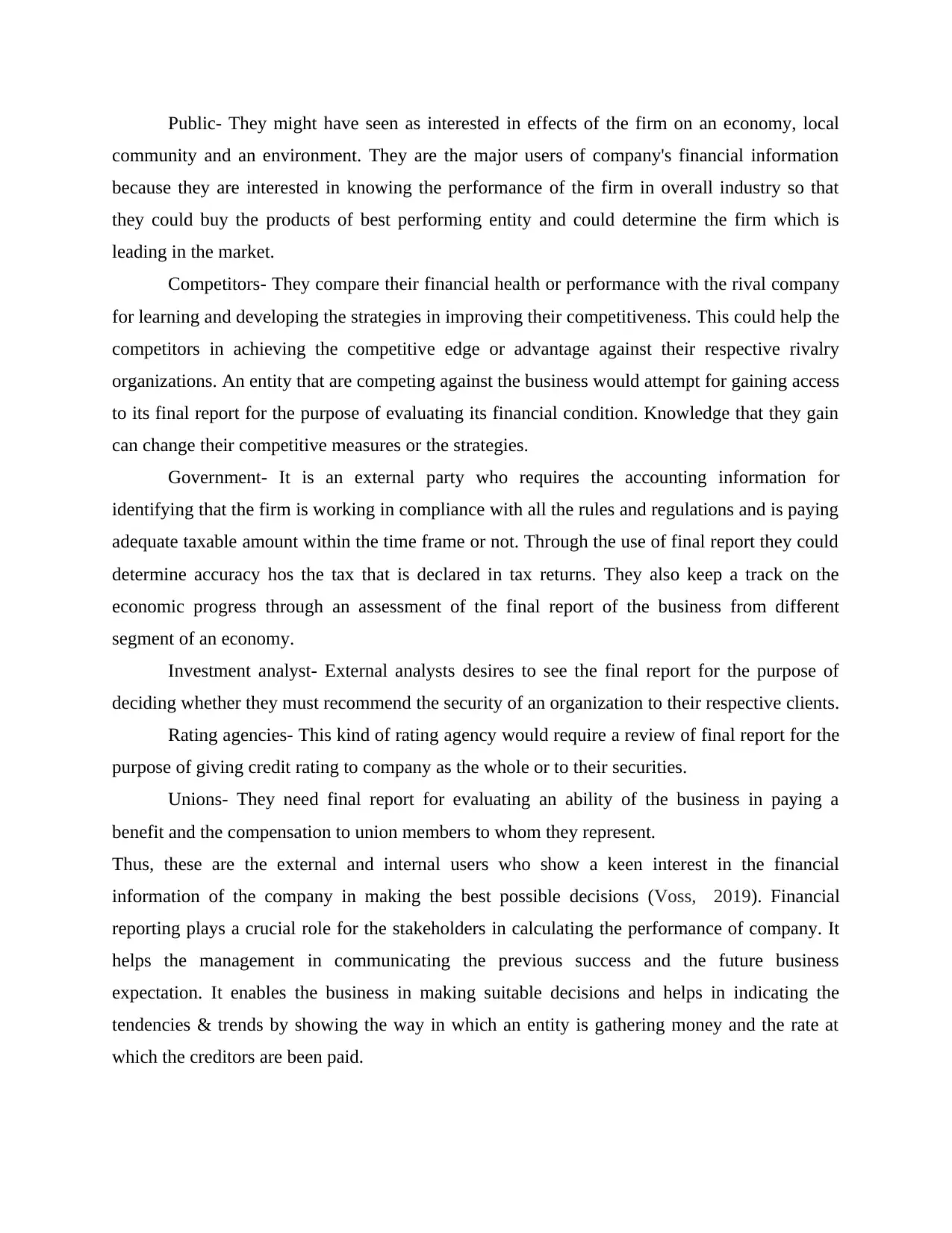
Public- They might have seen as interested in effects of the firm on an economy, local
community and an environment. They are the major users of company's financial information
because they are interested in knowing the performance of the firm in overall industry so that
they could buy the products of best performing entity and could determine the firm which is
leading in the market.
Competitors- They compare their financial health or performance with the rival company
for learning and developing the strategies in improving their competitiveness. This could help the
competitors in achieving the competitive edge or advantage against their respective rivalry
organizations. An entity that are competing against the business would attempt for gaining access
to its final report for the purpose of evaluating its financial condition. Knowledge that they gain
can change their competitive measures or the strategies.
Government- It is an external party who requires the accounting information for
identifying that the firm is working in compliance with all the rules and regulations and is paying
adequate taxable amount within the time frame or not. Through the use of final report they could
determine accuracy hos the tax that is declared in tax returns. They also keep a track on the
economic progress through an assessment of the final report of the business from different
segment of an economy.
Investment analyst- External analysts desires to see the final report for the purpose of
deciding whether they must recommend the security of an organization to their respective clients.
Rating agencies- This kind of rating agency would require a review of final report for the
purpose of giving credit rating to company as the whole or to their securities.
Unions- They need final report for evaluating an ability of the business in paying a
benefit and the compensation to union members to whom they represent.
Thus, these are the external and internal users who show a keen interest in the financial
information of the company in making the best possible decisions (Voss, 2019). Financial
reporting plays a crucial role for the stakeholders in calculating the performance of company. It
helps the management in communicating the previous success and the future business
expectation. It enables the business in making suitable decisions and helps in indicating the
tendencies & trends by showing the way in which an entity is gathering money and the rate at
which the creditors are been paid.
community and an environment. They are the major users of company's financial information
because they are interested in knowing the performance of the firm in overall industry so that
they could buy the products of best performing entity and could determine the firm which is
leading in the market.
Competitors- They compare their financial health or performance with the rival company
for learning and developing the strategies in improving their competitiveness. This could help the
competitors in achieving the competitive edge or advantage against their respective rivalry
organizations. An entity that are competing against the business would attempt for gaining access
to its final report for the purpose of evaluating its financial condition. Knowledge that they gain
can change their competitive measures or the strategies.
Government- It is an external party who requires the accounting information for
identifying that the firm is working in compliance with all the rules and regulations and is paying
adequate taxable amount within the time frame or not. Through the use of final report they could
determine accuracy hos the tax that is declared in tax returns. They also keep a track on the
economic progress through an assessment of the final report of the business from different
segment of an economy.
Investment analyst- External analysts desires to see the final report for the purpose of
deciding whether they must recommend the security of an organization to their respective clients.
Rating agencies- This kind of rating agency would require a review of final report for the
purpose of giving credit rating to company as the whole or to their securities.
Unions- They need final report for evaluating an ability of the business in paying a
benefit and the compensation to union members to whom they represent.
Thus, these are the external and internal users who show a keen interest in the financial
information of the company in making the best possible decisions (Voss, 2019). Financial
reporting plays a crucial role for the stakeholders in calculating the performance of company. It
helps the management in communicating the previous success and the future business
expectation. It enables the business in making suitable decisions and helps in indicating the
tendencies & trends by showing the way in which an entity is gathering money and the rate at
which the creditors are been paid.
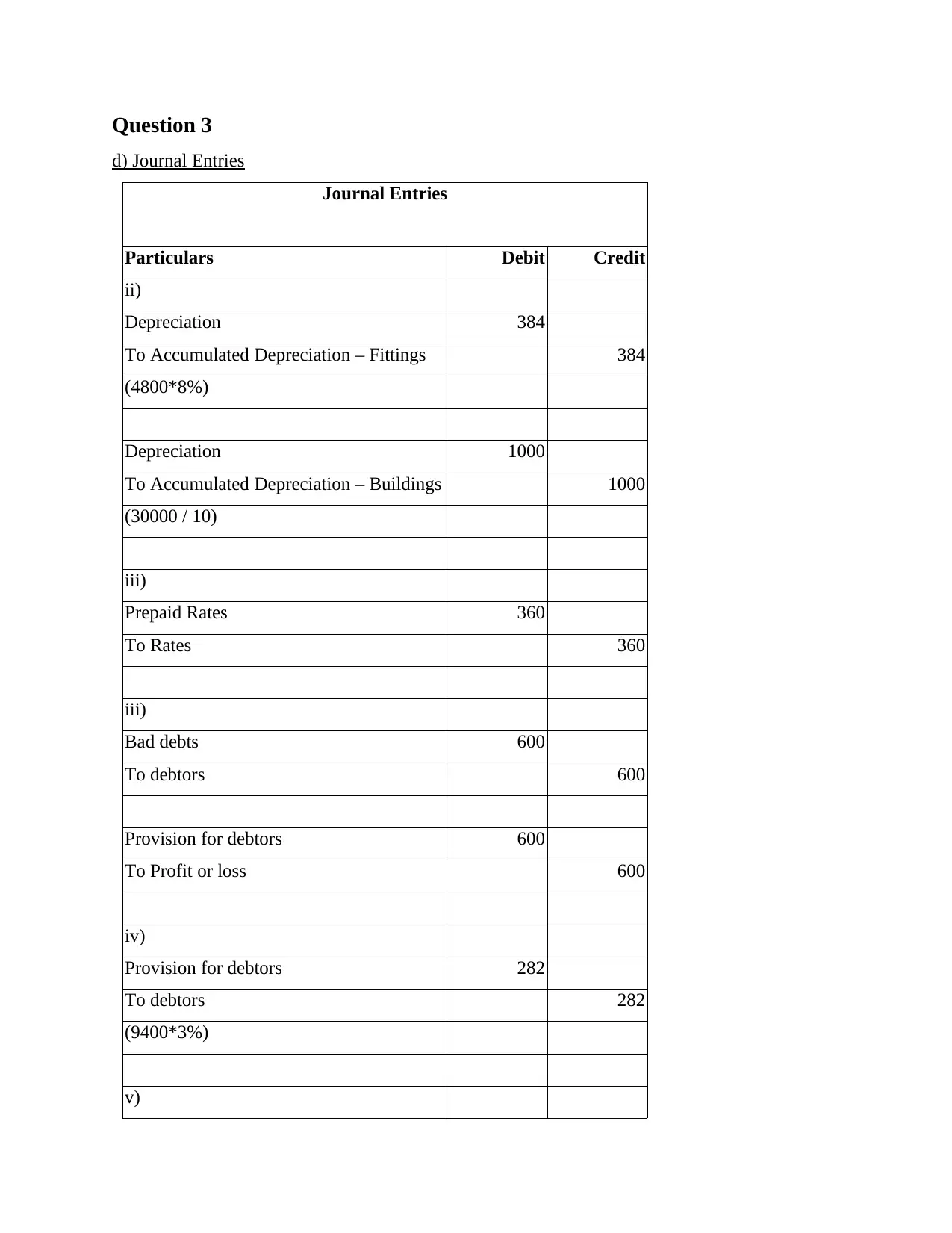
Question 3
d) Journal Entries
Journal Entries
Particulars Debit Credit
ii)
Depreciation 384
To Accumulated Depreciation – Fittings 384
(4800*8%)
Depreciation 1000
To Accumulated Depreciation – Buildings 1000
(30000 / 10)
iii)
Prepaid Rates 360
To Rates 360
iii)
Bad debts 600
To debtors 600
Provision for debtors 600
To Profit or loss 600
iv)
Provision for debtors 282
To debtors 282
(9400*3%)
v)
d) Journal Entries
Journal Entries
Particulars Debit Credit
ii)
Depreciation 384
To Accumulated Depreciation – Fittings 384
(4800*8%)
Depreciation 1000
To Accumulated Depreciation – Buildings 1000
(30000 / 10)
iii)
Prepaid Rates 360
To Rates 360
iii)
Bad debts 600
To debtors 600
Provision for debtors 600
To Profit or loss 600
iv)
Provision for debtors 282
To debtors 282
(9400*3%)
v)
Secure Best Marks with AI Grader
Need help grading? Try our AI Grader for instant feedback on your assignments.
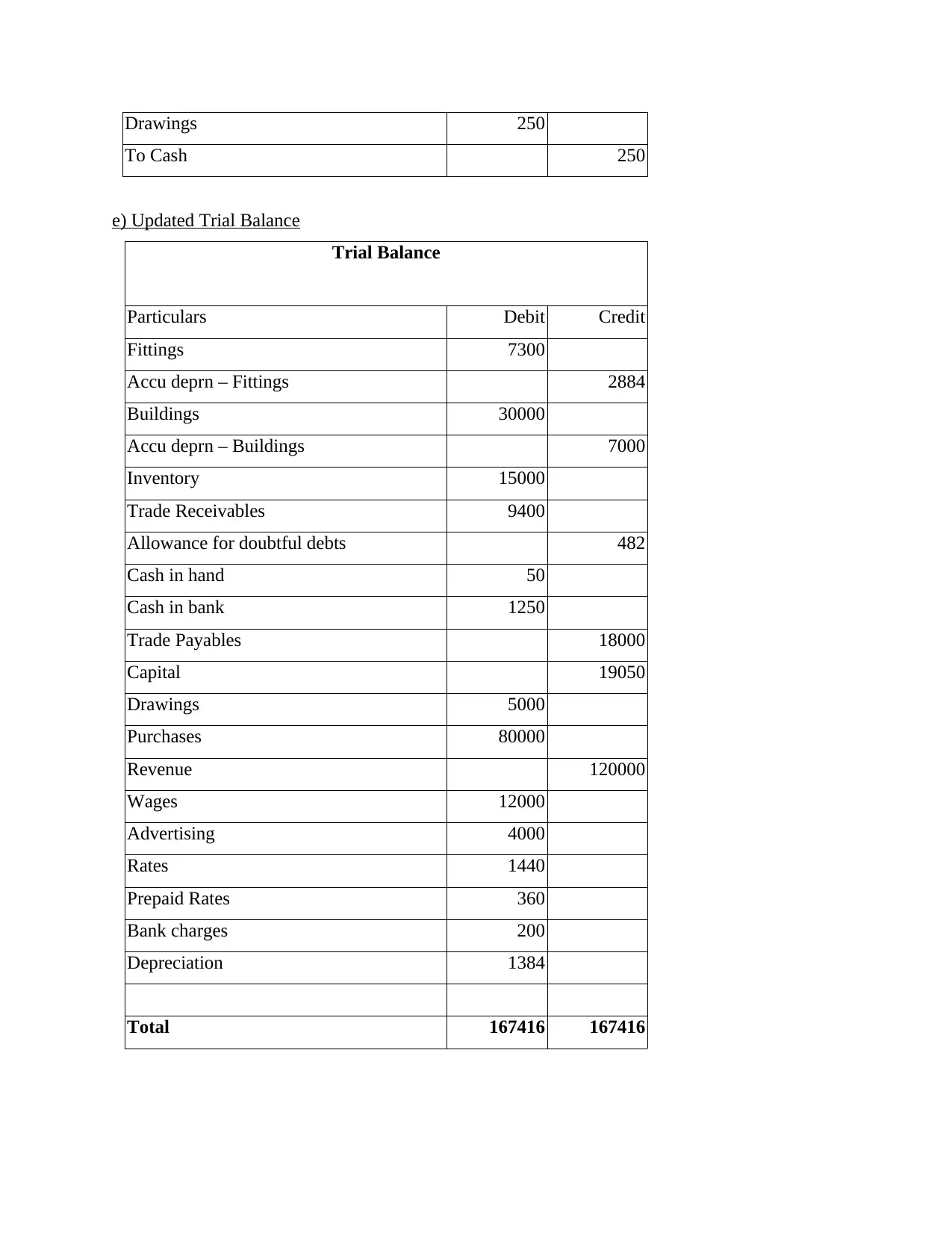
Drawings 250
To Cash 250
e) Updated Trial Balance
Trial Balance
Particulars Debit Credit
Fittings 7300
Accu deprn – Fittings 2884
Buildings 30000
Accu deprn – Buildings 7000
Inventory 15000
Trade Receivables 9400
Allowance for doubtful debts 482
Cash in hand 50
Cash in bank 1250
Trade Payables 18000
Capital 19050
Drawings 5000
Purchases 80000
Revenue 120000
Wages 12000
Advertising 4000
Rates 1440
Prepaid Rates 360
Bank charges 200
Depreciation 1384
Total 167416 167416
To Cash 250
e) Updated Trial Balance
Trial Balance
Particulars Debit Credit
Fittings 7300
Accu deprn – Fittings 2884
Buildings 30000
Accu deprn – Buildings 7000
Inventory 15000
Trade Receivables 9400
Allowance for doubtful debts 482
Cash in hand 50
Cash in bank 1250
Trade Payables 18000
Capital 19050
Drawings 5000
Purchases 80000
Revenue 120000
Wages 12000
Advertising 4000
Rates 1440
Prepaid Rates 360
Bank charges 200
Depreciation 1384
Total 167416 167416
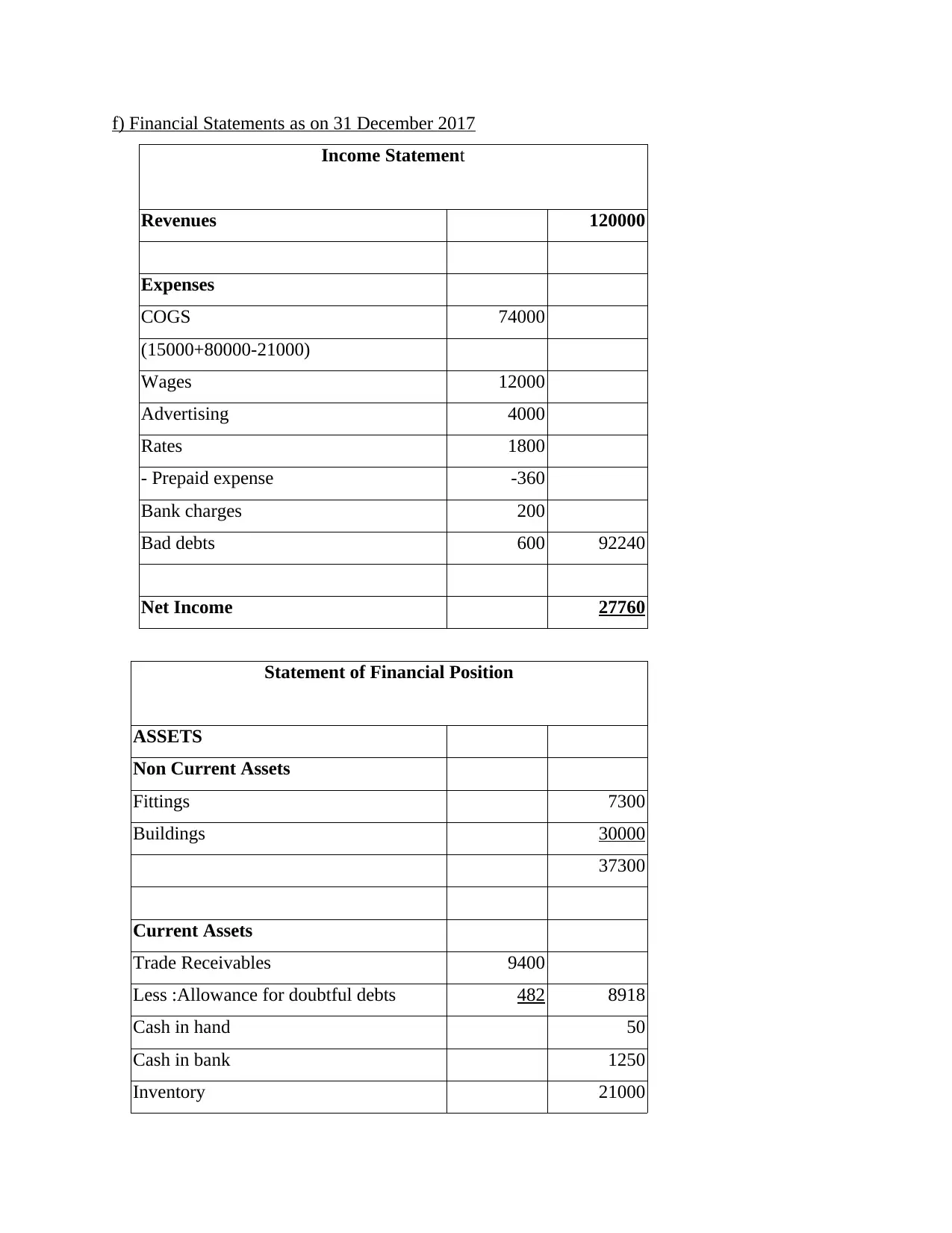
f) Financial Statements as on 31 December 2017
Income Statement
Revenues 120000
Expenses
COGS 74000
(15000+80000-21000)
Wages 12000
Advertising 4000
Rates 1800
- Prepaid expense -360
Bank charges 200
Bad debts 600 92240
Net Income 27760
Statement of Financial Position
ASSETS
Non Current Assets
Fittings 7300
Buildings 30000
37300
Current Assets
Trade Receivables 9400
Less :Allowance for doubtful debts 482 8918
Cash in hand 50
Cash in bank 1250
Inventory 21000
Income Statement
Revenues 120000
Expenses
COGS 74000
(15000+80000-21000)
Wages 12000
Advertising 4000
Rates 1800
- Prepaid expense -360
Bank charges 200
Bad debts 600 92240
Net Income 27760
Statement of Financial Position
ASSETS
Non Current Assets
Fittings 7300
Buildings 30000
37300
Current Assets
Trade Receivables 9400
Less :Allowance for doubtful debts 482 8918
Cash in hand 50
Cash in bank 1250
Inventory 21000
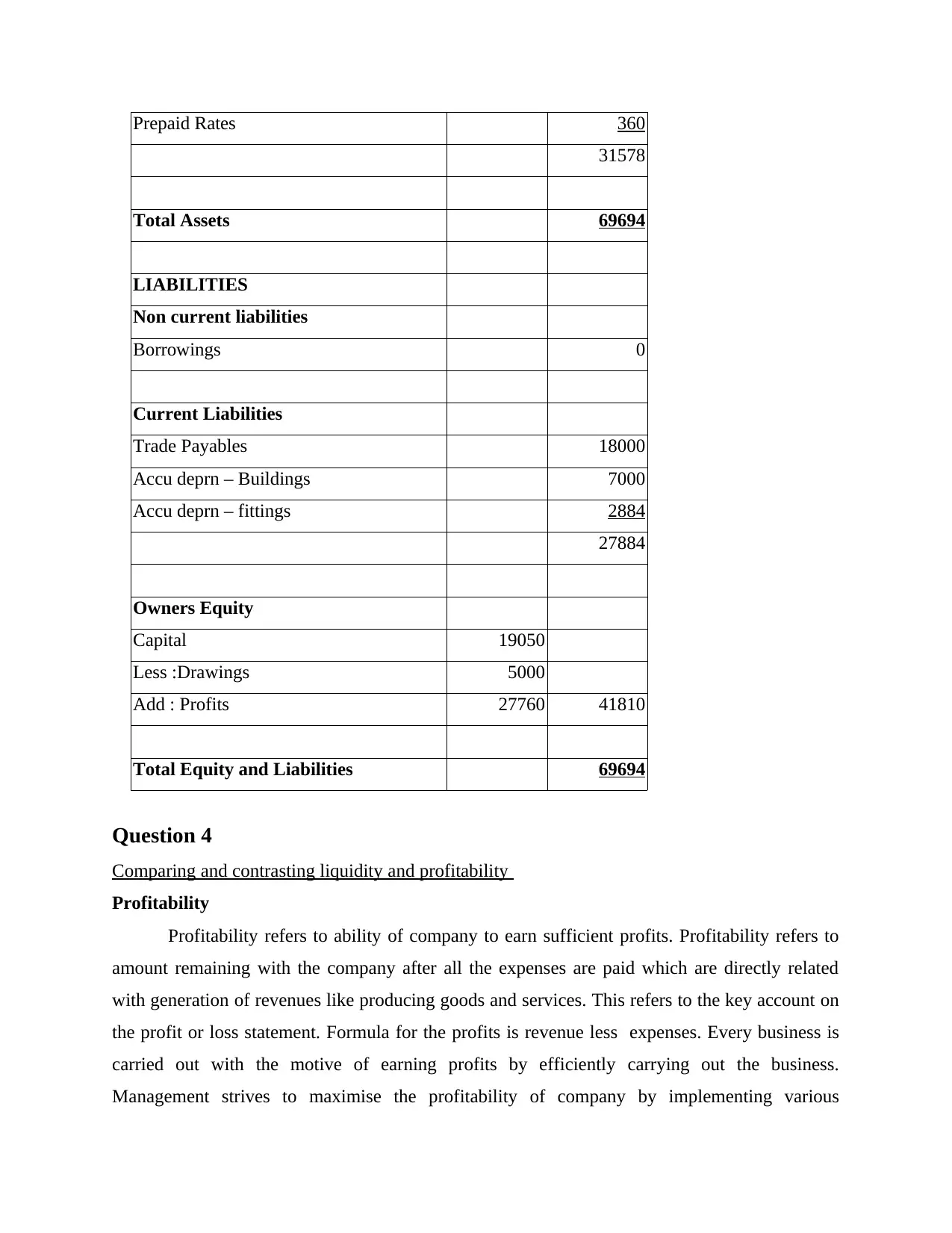
Prepaid Rates 360
31578
Total Assets 69694
LIABILITIES
Non current liabilities
Borrowings 0
Current Liabilities
Trade Payables 18000
Accu deprn – Buildings 7000
Accu deprn – fittings 2884
27884
Owners Equity
Capital 19050
Less :Drawings 5000
Add : Profits 27760 41810
Total Equity and Liabilities 69694
Question 4
Comparing and contrasting liquidity and profitability
Profitability
Profitability refers to ability of company to earn sufficient profits. Profitability refers to
amount remaining with the company after all the expenses are paid which are directly related
with generation of revenues like producing goods and services. This refers to the key account on
the profit or loss statement. Formula for the profits is revenue less expenses. Every business is
carried out with the motive of earning profits by efficiently carrying out the business.
Management strives to maximise the profitability of company by implementing various
31578
Total Assets 69694
LIABILITIES
Non current liabilities
Borrowings 0
Current Liabilities
Trade Payables 18000
Accu deprn – Buildings 7000
Accu deprn – fittings 2884
27884
Owners Equity
Capital 19050
Less :Drawings 5000
Add : Profits 27760 41810
Total Equity and Liabilities 69694
Question 4
Comparing and contrasting liquidity and profitability
Profitability
Profitability refers to ability of company to earn sufficient profits. Profitability refers to
amount remaining with the company after all the expenses are paid which are directly related
with generation of revenues like producing goods and services. This refers to the key account on
the profit or loss statement. Formula for the profits is revenue less expenses. Every business is
carried out with the motive of earning profits by efficiently carrying out the business.
Management strives to maximise the profitability of company by implementing various
Paraphrase This Document
Need a fresh take? Get an instant paraphrase of this document with our AI Paraphraser
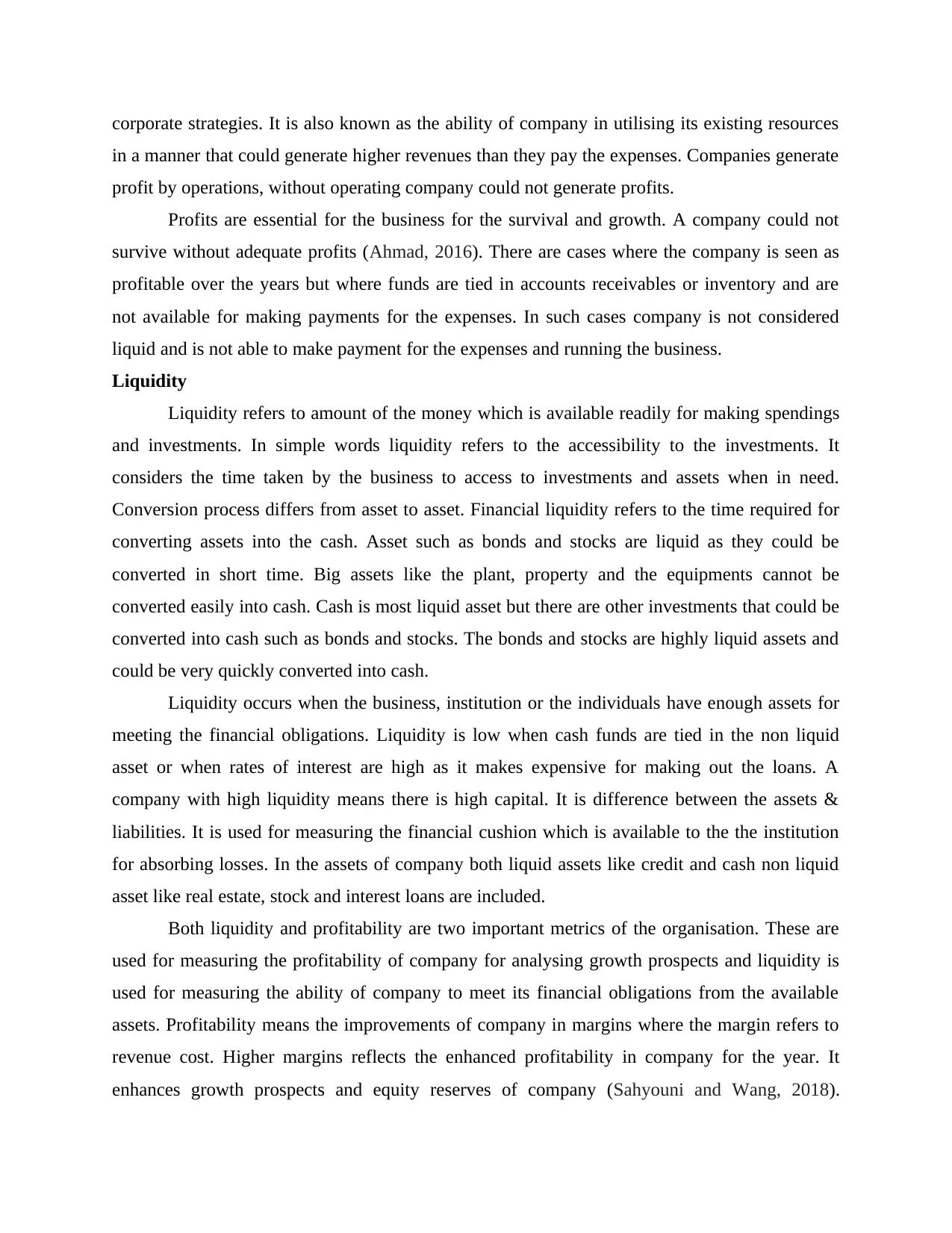
corporate strategies. It is also known as the ability of company in utilising its existing resources
in a manner that could generate higher revenues than they pay the expenses. Companies generate
profit by operations, without operating company could not generate profits.
Profits are essential for the business for the survival and growth. A company could not
survive without adequate profits (Ahmad, 2016). There are cases where the company is seen as
profitable over the years but where funds are tied in accounts receivables or inventory and are
not available for making payments for the expenses. In such cases company is not considered
liquid and is not able to make payment for the expenses and running the business.
Liquidity
Liquidity refers to amount of the money which is available readily for making spendings
and investments. In simple words liquidity refers to the accessibility to the investments. It
considers the time taken by the business to access to investments and assets when in need.
Conversion process differs from asset to asset. Financial liquidity refers to the time required for
converting assets into the cash. Asset such as bonds and stocks are liquid as they could be
converted in short time. Big assets like the plant, property and the equipments cannot be
converted easily into cash. Cash is most liquid asset but there are other investments that could be
converted into cash such as bonds and stocks. The bonds and stocks are highly liquid assets and
could be very quickly converted into cash.
Liquidity occurs when the business, institution or the individuals have enough assets for
meeting the financial obligations. Liquidity is low when cash funds are tied in the non liquid
asset or when rates of interest are high as it makes expensive for making out the loans. A
company with high liquidity means there is high capital. It is difference between the assets &
liabilities. It is used for measuring the financial cushion which is available to the the institution
for absorbing losses. In the assets of company both liquid assets like credit and cash non liquid
asset like real estate, stock and interest loans are included.
Both liquidity and profitability are two important metrics of the organisation. These are
used for measuring the profitability of company for analysing growth prospects and liquidity is
used for measuring the ability of company to meet its financial obligations from the available
assets. Profitability means the improvements of company in margins where the margin refers to
revenue cost. Higher margins reflects the enhanced profitability in company for the year. It
enhances growth prospects and equity reserves of company (Sahyouni and Wang, 2018).
in a manner that could generate higher revenues than they pay the expenses. Companies generate
profit by operations, without operating company could not generate profits.
Profits are essential for the business for the survival and growth. A company could not
survive without adequate profits (Ahmad, 2016). There are cases where the company is seen as
profitable over the years but where funds are tied in accounts receivables or inventory and are
not available for making payments for the expenses. In such cases company is not considered
liquid and is not able to make payment for the expenses and running the business.
Liquidity
Liquidity refers to amount of the money which is available readily for making spendings
and investments. In simple words liquidity refers to the accessibility to the investments. It
considers the time taken by the business to access to investments and assets when in need.
Conversion process differs from asset to asset. Financial liquidity refers to the time required for
converting assets into the cash. Asset such as bonds and stocks are liquid as they could be
converted in short time. Big assets like the plant, property and the equipments cannot be
converted easily into cash. Cash is most liquid asset but there are other investments that could be
converted into cash such as bonds and stocks. The bonds and stocks are highly liquid assets and
could be very quickly converted into cash.
Liquidity occurs when the business, institution or the individuals have enough assets for
meeting the financial obligations. Liquidity is low when cash funds are tied in the non liquid
asset or when rates of interest are high as it makes expensive for making out the loans. A
company with high liquidity means there is high capital. It is difference between the assets &
liabilities. It is used for measuring the financial cushion which is available to the the institution
for absorbing losses. In the assets of company both liquid assets like credit and cash non liquid
asset like real estate, stock and interest loans are included.
Both liquidity and profitability are two important metrics of the organisation. These are
used for measuring the profitability of company for analysing growth prospects and liquidity is
used for measuring the ability of company to meet its financial obligations from the available
assets. Profitability means the improvements of company in margins where the margin refers to
revenue cost. Higher margins reflects the enhanced profitability in company for the year. It
enhances growth prospects and equity reserves of company (Sahyouni and Wang, 2018).
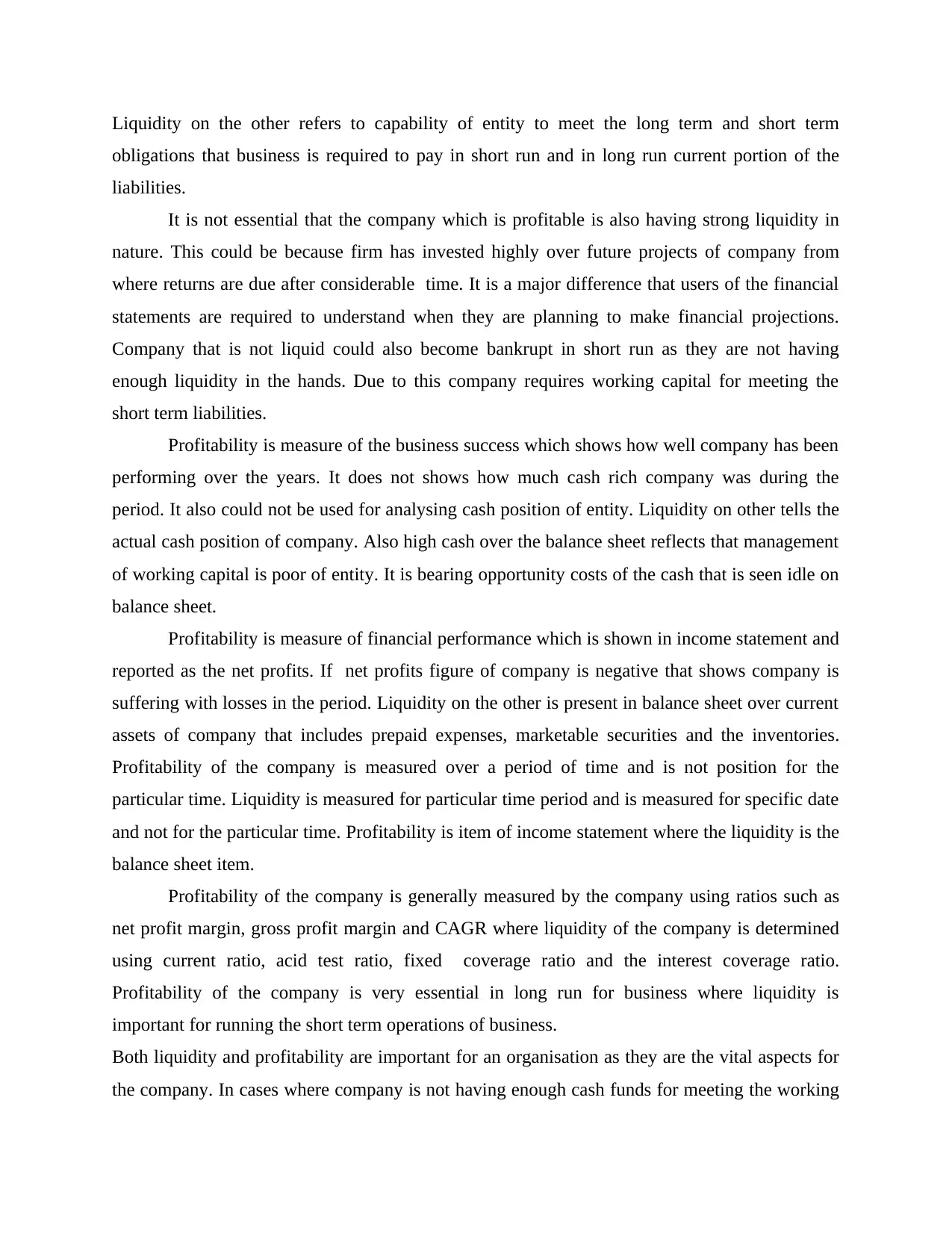
Liquidity on the other refers to capability of entity to meet the long term and short term
obligations that business is required to pay in short run and in long run current portion of the
liabilities.
It is not essential that the company which is profitable is also having strong liquidity in
nature. This could be because firm has invested highly over future projects of company from
where returns are due after considerable time. It is a major difference that users of the financial
statements are required to understand when they are planning to make financial projections.
Company that is not liquid could also become bankrupt in short run as they are not having
enough liquidity in the hands. Due to this company requires working capital for meeting the
short term liabilities.
Profitability is measure of the business success which shows how well company has been
performing over the years. It does not shows how much cash rich company was during the
period. It also could not be used for analysing cash position of entity. Liquidity on other tells the
actual cash position of company. Also high cash over the balance sheet reflects that management
of working capital is poor of entity. It is bearing opportunity costs of the cash that is seen idle on
balance sheet.
Profitability is measure of financial performance which is shown in income statement and
reported as the net profits. If net profits figure of company is negative that shows company is
suffering with losses in the period. Liquidity on the other is present in balance sheet over current
assets of company that includes prepaid expenses, marketable securities and the inventories.
Profitability of the company is measured over a period of time and is not position for the
particular time. Liquidity is measured for particular time period and is measured for specific date
and not for the particular time. Profitability is item of income statement where the liquidity is the
balance sheet item.
Profitability of the company is generally measured by the company using ratios such as
net profit margin, gross profit margin and CAGR where liquidity of the company is determined
using current ratio, acid test ratio, fixed coverage ratio and the interest coverage ratio.
Profitability of the company is very essential in long run for business where liquidity is
important for running the short term operations of business.
Both liquidity and profitability are important for an organisation as they are the vital aspects for
the company. In cases where company is not having enough cash funds for meeting the working
obligations that business is required to pay in short run and in long run current portion of the
liabilities.
It is not essential that the company which is profitable is also having strong liquidity in
nature. This could be because firm has invested highly over future projects of company from
where returns are due after considerable time. It is a major difference that users of the financial
statements are required to understand when they are planning to make financial projections.
Company that is not liquid could also become bankrupt in short run as they are not having
enough liquidity in the hands. Due to this company requires working capital for meeting the
short term liabilities.
Profitability is measure of the business success which shows how well company has been
performing over the years. It does not shows how much cash rich company was during the
period. It also could not be used for analysing cash position of entity. Liquidity on other tells the
actual cash position of company. Also high cash over the balance sheet reflects that management
of working capital is poor of entity. It is bearing opportunity costs of the cash that is seen idle on
balance sheet.
Profitability is measure of financial performance which is shown in income statement and
reported as the net profits. If net profits figure of company is negative that shows company is
suffering with losses in the period. Liquidity on the other is present in balance sheet over current
assets of company that includes prepaid expenses, marketable securities and the inventories.
Profitability of the company is measured over a period of time and is not position for the
particular time. Liquidity is measured for particular time period and is measured for specific date
and not for the particular time. Profitability is item of income statement where the liquidity is the
balance sheet item.
Profitability of the company is generally measured by the company using ratios such as
net profit margin, gross profit margin and CAGR where liquidity of the company is determined
using current ratio, acid test ratio, fixed coverage ratio and the interest coverage ratio.
Profitability of the company is very essential in long run for business where liquidity is
important for running the short term operations of business.
Both liquidity and profitability are important for an organisation as they are the vital aspects for
the company. In cases where company is not having enough cash funds for meeting the working

capital requirements it has to go for working capital loan (Guragai, Hutchison, and Farris,
2019). This will in turn also increase interest cost of the entity. Profitability of the company is
vital as firm needs to asses the reasons for the low profit growth and is required to focus over
cost reduction by application of effective corporate strategies.
2019). This will in turn also increase interest cost of the entity. Profitability of the company is
vital as firm needs to asses the reasons for the low profit growth and is required to focus over
cost reduction by application of effective corporate strategies.
Secure Best Marks with AI Grader
Need help grading? Try our AI Grader for instant feedback on your assignments.
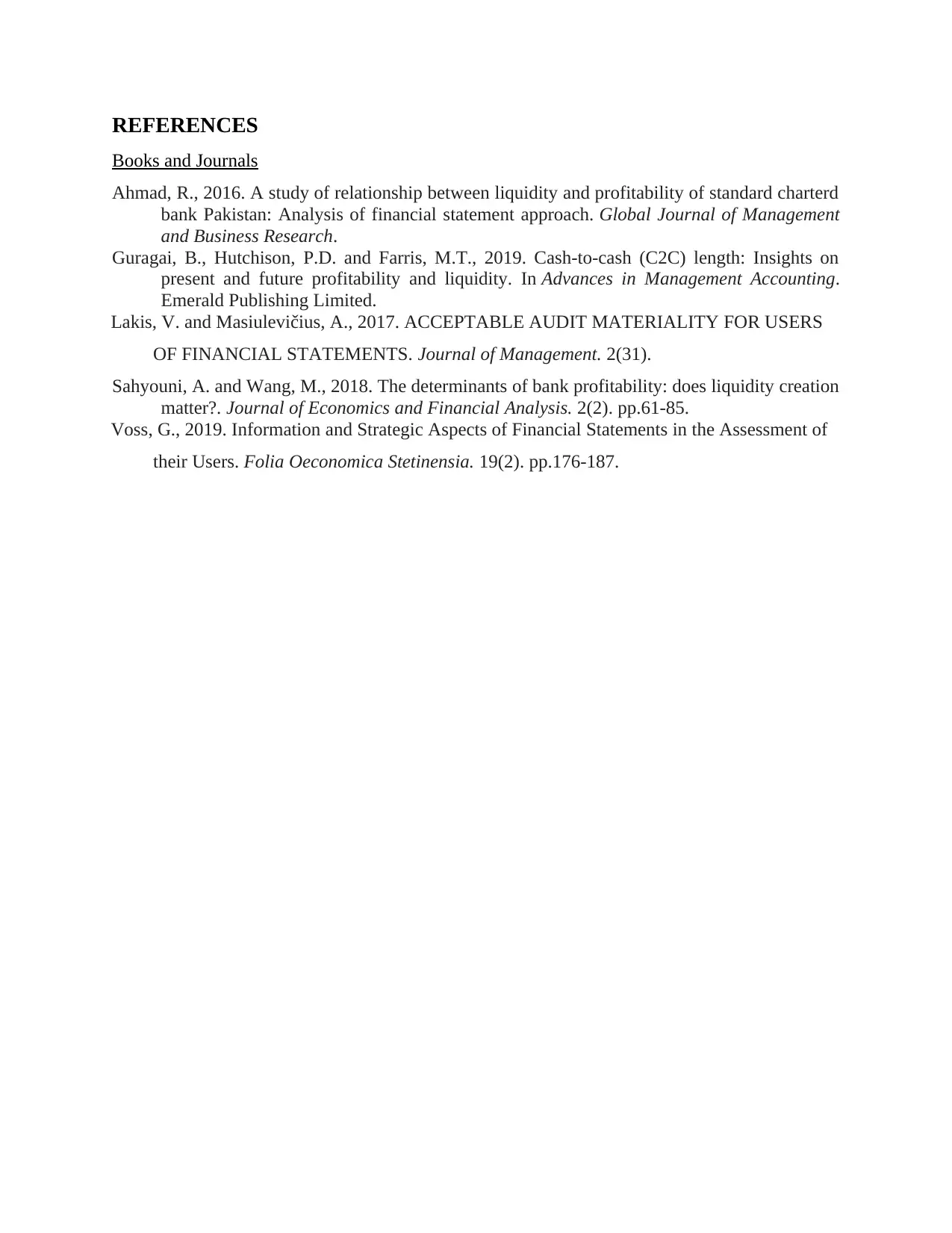
REFERENCES
Books and Journals
Ahmad, R., 2016. A study of relationship between liquidity and profitability of standard charterd
bank Pakistan: Analysis of financial statement approach. Global Journal of Management
and Business Research.
Guragai, B., Hutchison, P.D. and Farris, M.T., 2019. Cash-to-cash (C2C) length: Insights on
present and future profitability and liquidity. In Advances in Management Accounting.
Emerald Publishing Limited.
Lakis, V. and Masiulevičius, A., 2017. ACCEPTABLE AUDIT MATERIALITY FOR USERS
OF FINANCIAL STATEMENTS. Journal of Management. 2(31).
Sahyouni, A. and Wang, M., 2018. The determinants of bank profitability: does liquidity creation
matter?. Journal of Economics and Financial Analysis. 2(2). pp.61-85.
Voss, G., 2019. Information and Strategic Aspects of Financial Statements in the Assessment of
their Users. Folia Oeconomica Stetinensia. 19(2). pp.176-187.
Books and Journals
Ahmad, R., 2016. A study of relationship between liquidity and profitability of standard charterd
bank Pakistan: Analysis of financial statement approach. Global Journal of Management
and Business Research.
Guragai, B., Hutchison, P.D. and Farris, M.T., 2019. Cash-to-cash (C2C) length: Insights on
present and future profitability and liquidity. In Advances in Management Accounting.
Emerald Publishing Limited.
Lakis, V. and Masiulevičius, A., 2017. ACCEPTABLE AUDIT MATERIALITY FOR USERS
OF FINANCIAL STATEMENTS. Journal of Management. 2(31).
Sahyouni, A. and Wang, M., 2018. The determinants of bank profitability: does liquidity creation
matter?. Journal of Economics and Financial Analysis. 2(2). pp.61-85.
Voss, G., 2019. Information and Strategic Aspects of Financial Statements in the Assessment of
their Users. Folia Oeconomica Stetinensia. 19(2). pp.176-187.
1 out of 17
Related Documents
Your All-in-One AI-Powered Toolkit for Academic Success.
+13062052269
info@desklib.com
Available 24*7 on WhatsApp / Email
![[object Object]](/_next/static/media/star-bottom.7253800d.svg)
Unlock your academic potential
© 2024 | Zucol Services PVT LTD | All rights reserved.




